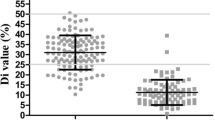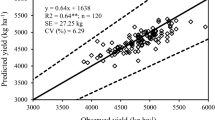Abstract
Two recombinant inbred lines (RILs) populations, RILSA derived from the cross between “Zhongyouzao8” (indica) and “Toyonihiki” (japonica) rice cultivars, and RILSB derived from the cross between “Qishanzhan” (indica) and “Akihikari” (japonica) rice cultivars, were grown in Liaoning and Sichuan Provinces, China to understand the effects of ecological environments on the subspecies characteristics and economic traits in filial generations of cross between indica and japonica. The results showed that both the subspecies characteristics and economic traits changed significantly. The effects of ecological environments on Cheng’s index and six subspecies characteristics were different on the basis of populations or characteristics. The distribution of Cheng’s index in RILSA was japonicalinous in Liaoning and Sichuan. The distribution of Cheng’s index in RILSB approached to normal distribution in Liaoning, but it was japonicalinous in Sichuan. As a whole, the two populations were more japonicalious in Sichuan than in Liaoning. The panicle number, seed setting rate and per-thousand-grain weight were decreased significantly in Sichuan. The grain number per panicle showed no significant change. A significant positive correlation was found between Cheng’s index and the economic traits, including six subspecies traits. It suggested that the reason that the filial generation of cross between indica and japonica in northern China showed japonicanous subspecies characteristics might be the artificial selection by breeders on the economic traits. In addition, indica-japonica differentiation and the relationship with ecological environments were discussed.
Similar content being viewed by others
References
Cai X X, Liu J, Qiu Y C, Zhao W, Song Z P, Lu B R (2006). Differentiation of indica-japonica rice revealed by insertion/deletion fragments obtained from comparative genomic study of DNA sequences between 93–11 (indica) and Nipponbare (japonica). Journal of Fudan University (Natural Science), 45(3): 309–315 (in Chinese)
Chen L Y, Xiong W, Yang J H, Xiao Y H, Liu G H, Tang W B, Sun C Q, Chen L, Zhu Z F (2002). Relationship between the extent of genetic differentiation in parental lines and seed setting percentage stability in intersubspecific hybrid rice. Journal of Hunan Agricultural University, 28(2): 89–92 (in Chinese)
Chen S H, Mao C Z, Zhan X D, Si H M, Sun Z X (2001). Construction of double haploid (DH) and recombinant inbred line (RIL) population of indica-japonica hybrid and their difference in indica and japonica property. Chinese Journal of Rice Science, 15(4): 257–260 (in Chinese)
Chen W F, Xu Z J, Zhang L B (2003). Physiological Basis of Rice Breeding for Super High Yield. Shenyang: Liaoning Science and Technology Press, 146–155 (in Chinese)
Cheng K S (1993). Discrimination of Hsien (indica) and Keng (japonica) Subspecies in Asian Cultivated Rice. Kunming: Yunnan Sci&Tech Press, 1–23 (in Chinese)
Chinese Academy of Agriculture Science (1984). Rice Cultivation in China. Beijing: Agricultural Press, 309–316 (in Chinese)
He G H, Zhen J K, Li Y, Yang Z L (1993). A comparative study on yield components of various type of rice. Journal of Southwest Agricultural University, 15(5): 438–440 (in Chinese)
Li R H, Xu C G (1998). Relationship between the extent of genetic differentiation in parental lines and heterosis of indica-japonica hybrid Rice. Acta Agronomica Sinica, 24(5): 564–576 (in Chinese)
Lin S C, Min S K (1991). Chinese Rice Varieties and Their Pedigree. Shanghai: Shanghai Sci&Tech Publishers, 106–138 (in Chinese)
Mei H W, Li Z K, Wang Y P, Yu X Q, Zhong D B, Luo L J, Ying C S (1997). The indica/japonica classification of “Lemont/Teqing” recombinated inbred lines (RILs) using Cheng’s index. Chinese Journal of Rice Science, 11(4): 193–197 (in Chinese)
Nonnatus S B, Renando S, Osamu K, Takasige I (2001). RAPD, RFLP and SSLP analyses of phylogenetic relationships between cultivated and wild species of rice. Genes Genet, 76: 71–79
Peng J H (1991). An analysis of genotype × environment interaction on grain yield and the differentiation of ecologic type region in rice. Journal of Sichuan Agricultural University, 9(3): 327–333 (in Chinese)
Peng J H, Li Y C (1990). The dissection and comparison of yield formation for indica and japonica subspecies in rice. Journal of Sichuan Agricultural University, 8(3): 162–168 (in Chinese)
Qi Z X, Shong W Q, Jin G, Chen R Y (2001). Genetic relatedness of wild and cultivated rice germplasm revealed by AFLP. Journal of Nankai University (Natural Science), 34(3): 74–80 (in Chinese)
Qian H R, Zhuang J Y, Lin H X, Lu J, Zheng K L (1995). Identification of a set of RFLP probes for subspecies differentiation in Oryza sativa L. Theor Appl Genet, 90: 878–884
Sun C Q, Jiang T B, Chen L, Wu C M, Li Z C, Wang X K (2000). Studies on the relationship between heterosis and genetic differentiation in hybrid rice (Oryza sativa L.). Acta Agronomica Sinica, 26(6): 641–649 (in Chinese)
Sun C Q, Wang X K, Li Z C (2001). Comparison of the genetic diversity of common wild rice (Oryza rufipogon Griff.) and cultivated rice (Oryza sativa L.) using RFLP markers. Theor Appl Genet, 102: 157–162
Wang S W, Liu X, Wang Y (2006). Genome polymorphisms between indica and japonica revealed by RFLP. Scientia Agricultura Sinica, 39(5): 1038–1043 (in Chinese)
Wang X K, Li R H, Sun C Q (1997). Identification and taxonomy of subspecies of Asia cultivated rice and the hybrids between subspecies. Chinese Science Bulletin, 42(24): 2596–2603 (in Chinese)
Wang Z S, Cheng H (1996). RAPD determinations on the genetic differentiation of Chinese common wild rice. Acta Botanica Sinica, 38(9): 749–752 (in Chinese)
Wu C M, Sun C Q, Fu X L, Wang X K, Li Z C, Zhang Q (2003). Study on the relationship between quality, yield characters or indicajaponica differentiation in rice (Oryza sativa L.). Acta Agronomica Sinica, 29(6): 822–828 (in Chinese)
Xiong Z M, Cheng S H, Cao L Y (1989). Present situations and prospects for the research of utilization of vigor in hybrids between indica and japonica rice. Rice Abstr & Rev, (5): 1–4 (in Chinese)
Xu Z J, Chen W F, Zhang L B, Peng Y C, Zhang J G (1996). Differences and inheritance of neck vascular bundles between different rice types. Acta Agronomica Sinica, 22(2): 167–172 (in Chinese)
Xu Z J, Li J Q, Huang R D, Jiang J, Chen W F, Zhang L B (2003a). Subspecies characteristics and classification of rice varieties developed through indica and japonica crossing. Scientia Agricultura Sinica, 36(12): 1571–1575 (in Chinese)
Xu Z J, Li J Q, Jiang J, Jing Y H, Zhang W Z, Chen W F, Zhang L B (2003b). Subspecies characteristics and their relationships with economic characters. Acta Agronomica Sinica, 29(5): 735–739 (in Chinese)
Yang S R, Zhang L B, Chen W F, Xu Z J, Wang J M (1996). Theories and methods of rice breeding for maximum yield. Acta Agronomica Sinica, 22(3): 295–304 (in Chinese)
Yang S R, Zhao J S (1959). Studies on indica and japonica rice breeding. Acta Agricultura Sinica, 10(4): 256–268 (in Chinese)
Yang Z Y, Liu W Y (1991). Classification of the F1 intersubspecific hybrids between indica and japonica and its relation to the F1 hybrid vigor. Chinese Journal of Rice Science, 5(4): 151–156 (in Chinese)
Yuan L P (1997). Hybrid rice breeding for super high yield. Hybrid Rice, 12(6): 1–3 (in Chinese)
Yuzo Futsuhara (1990). Genetics. In: Science of the Rice Plant, Vol. 3. Tokyo: Food and Agriculture Policy Research Center, 661–664
Zhou J S, Lu C G (2005). Practice and thinking on rice breeding for high yield. Acta Agronomica Sinica, 31(2): 254–258 (in Chinese)
Zhou K D, Wang X D, Li S G, Li P, Li H Y, Huang G S, Liu T Q, Shen M S (1997). The study on heavy panicle type of intersubspecific hybrid rice (Oryza sativa L.). Scientia Agricultura Sinica, 30(5): 91–93 (in Chinese)
Author information
Authors and Affiliations
Corresponding author
Additional information
__________
Translated from Progress in Natural Science, 2007, 17(8): 42–47 [译自: 自然科学进展]
About this article
Cite this article
Xu, H., Liu, H., Zhu, C. et al. Effect of ecological environments on subspecies characteristics and economic traits in filial generations of cross between indica and japonica rice. Front. Agric. China 2, 23–29 (2008). https://doi.org/10.1007/s11703-008-0006-6
Issue Date:
DOI: https://doi.org/10.1007/s11703-008-0006-6




